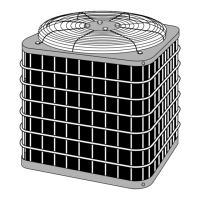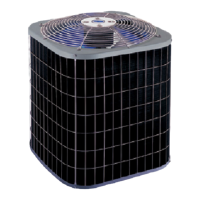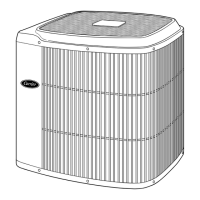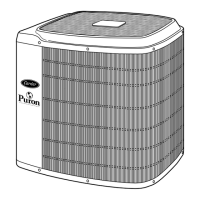5. Set room thermostat to HEAT or COOL and fan control to ON
or AUTO mode, as desired. Operate unit for a minimum of 15
minutes. Check system-refrigerant charge.
To avoid equipment damage ensure compressor rotation is
correct.•3-phase scroll compressors are rotation sensitive.
•A flashing LED on phase monitor indicates reverse rotation.
(See Fig. 8 and Table 2.)
This will not allow contactor to be energized.
•Disconnect power to unit and interchange 2 field-wiring
leads on unit contactor.
Step 13—Check Charge
Factory charge is shown on unit-rating plate. To check charge in
cooling mode, refer to Cooling-Only Procedure on unit wiring and
charging label.
COOLING-ONLY PROCEDURE
NOTE: If superheat- or subcooling-charging conditions are not
favorable, charge must be weighed in accordance with unit-rating
plate ±0.6 oz/ft of 3/8-in. liquid line above or below 15 ft
respectively.
EXAMPLE:
To calculate additional charge required for a 25-ft line set:
25 ft – 15 ft = 10 ft X 0.6 oz/ft=6ozofadditional charge
HEATING CHECK-CHART PROCEDURE
To check system operation during heating cycle, refer to the
Heating Check Chart on outdoor unit. This chart indicates whether
a correct relationship exists between system operating pressure and
air temperature entering indoor and outdoor units. If pressure and
temperature do not match on chart, system-refrigerant charge may
not be correct. Do not use chart to adjust refrigerant charge.
NOTE: When charging is necessary during heating season,
charge must be weighed in accordance with unit rating plate ±0.6
oz/ft of 3/8-in. liquid line above or below 15 ft respectively.
Step 14—Final Checks
IMPORTANT: Before leaving job, be sure to do the following:
1. Securely fasten all panels and covers.
2. Tighten service valve-stem caps to 1/12-turn past finger-tight.
3. Leave User’s Manual with owner. Explain system operation
and periodic maintenance requirements outlined in manual.
4. Fill out Dealer Installation Checklist and place in customer
file.
SEQUENCE OF OPERATION
With power supplied to indoor and outdoor units, transformer is
energized.
Cooling
On a call for cooling, thermostat makes circuits R-O, R-Y, and
R-G. Circuit R-O energizes reversing valve, switching it to cooling
position. On 3-phase models with scroll compressors, the units are
equipped with a phase monitor to detect if the incoming power is
correctly phased for compressor operation. If phasing is correct,
circuit R-Y energizes contactor, starting outdoor-fan motor and
compressor circuit. R-G energizes indoor unit-blower relay, start-
ing indoor-blower motor on high speed.
Fig. 7—Generic Wiring Diagram
(See Thermostat Installation Instructions
for wiring specific unit combinations.)
A02325
24 VAC HOT
R
C
W2
Y
G
R
C
RVS COOLING
C
W2
HP THERMOSTAT
TYPICAL
FAN COIL
HEAT
PUMP
G
O
E
W2
E
W3
R
Y
24 VAC COM
HEAT STAGE 2
COOL/HEAT
STAGE 1
INDOOR FAN
EMERGENCY
HEAT
O
*
*
*
IF AVAILABLE
*
LEGEND
24-V FACTORY WIRING
24-V FIELD WIRING
FIELD SPLICE CONNECTION
OUTDOOR THERMOSTAT
EMERGENCY HEAT RELAY
SUPPLEMENTAL HEAT RELAY
SHR
EHR
ODT
5
→
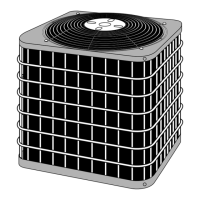
